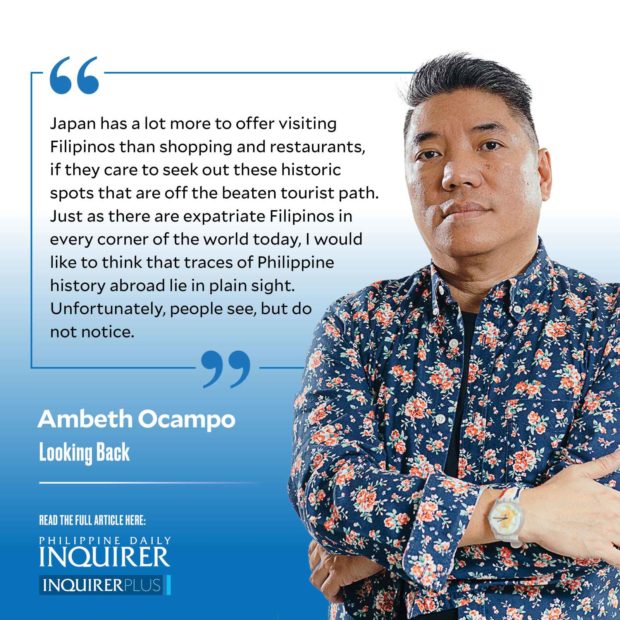Traces of Philippine history abroad
After two years of pandemic lockdown, many people I know have gone abroad on “revenge travel.” Many of them, discovering or revisiting nearby Japan and Korea, ask me where to eat in Tokyo or Kyoto that I know quite well from numerous trips from 2002 to 2020, when I visited Japan almost every year with some extended stays in the Kansai area, beginning with two weeks in Nara in 2002, six months in Kyoto in 2003, and another two months in 2010. I liked Kyoto, the ancient capital, because it was best explored on a bicycle. Well-meaning Japanese friends wanted to wean me from “provincial” Kyoto and introduced me to Tokyo that soon topped my list of favorite cities in the world after Metro Manila that I consider home. Tokyo became my “happy place,” having lived there for 19 months from 2012-2013, and two months in 2014. I made four trips to Japan in 2015, six in 2016, four in 2017 and 2018, then only one trip each in 2019, 2020, and 2022.
Joining a tour group is the best way for first-timers to get their bearings and experience the Japanese capital. Those who visit a second or third time can plan their own tour using online suggestions from Tripadvisor, Time Out Tokyo, or the Japan tourist office. However, these will not point Filipinos in the direction of two relevant spots in Hibiya Park: a bust of Rizal near the pond, and further down, a memorial to Elpidio Quirino. Originally installed in 1961, a marker was placed on the site of the former Tokyo Hotel where Rizal stayed in 1888; the bust of Rizal was added in 1998. I visit Rizal each time I am in Tokyo, and look at the stray coins, candy, and sometimes bottled water, placed at the base of the bust as offerings by visiting Filipinos.
The Quirino memorial installed in 2016 reminds both Japanese and Filipinos that, in 1953, Quirino granted executive clemency to 105 Japanese prisoners of war in Muntinlupa and sent them back to Japan. This act, while politically unpopular at a time when the wounds of World War II were still fresh in Filipino minds, paved the way for the normalization of relations between the Philippines and Japan, a relationship that remains strong to this day.
The residence of the Philippine ambassador to Japan, known as the Kudan, is also historically important because it served as the first Philippine Embassy ever, having been acquired and established during World War II. The European-style mansion set on an impressive plot of land close to the Imperial Palace grounds was the childhood home of Yoko Ono, widow of ex-Beatle John Lennon. Unfortunately, the mansion is not open to the public, but visitors can see it through its impressive wrought iron gate. Those with a romantic bent are advised to visit the Zoshigaya cemetery in Tokyo, where one of Rizal’s loves, Usui Seiko or O-sei san, is buried.
A memorial to the revolutionary general Artemio Ricarte can be visited in Yokohama. Ricarte and his wife ran a Filipino restaurant, the Karihan Luvimin (Luzon, Visayas, Mindanao), before the war, on 149 Yamashita-cho. On the site of the Ricarte Karihan now stands Heichinrou, reputedly the oldest Chinese restaurant in Japan. I have not located it yet, but another bit of Philippine history in Yokohama is the site of Mariano Ponce’s home. Ponce, a contributor to La Solidaridad, the Filipino reformist paper in Spain, was a friend of Jose Rizal. A regular visitor to the Ponce home was Dr. Sun Yat-sen, acknowledged as the founder of modern China.
Japan has a lot more to offer visiting Filipinos than shopping and restaurants, if they care to seek out these historic spots that are off the beaten tourist path. Just as there are expatriate Filipinos in every corner of the world today, I would like to think that traces of Philippine history abroad lie in plain sight. Unfortunately, people see, but do not notice. Looking back on my notes on Japan, I realize I have also completed research that can go into annotated walking tours of Philippine history: in Hong Kong, Singapore, Tokyo, Yokohama, Madrid, and Paris. Of course, it will be difficult and expensive to physically conduct these tours. Perhaps it is time to develop an app or website that can pull up pictures, maps, and my commentary online. Whenever I consider retirement, I am reminded of the ancient curse that applies to me—no rest for the wicked.
——————
Comments are welcome at aocampo@ateneo.edu

















